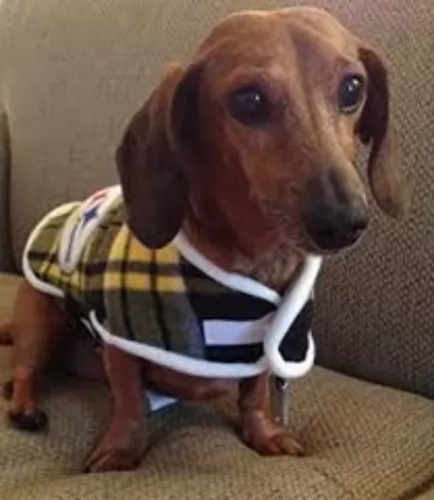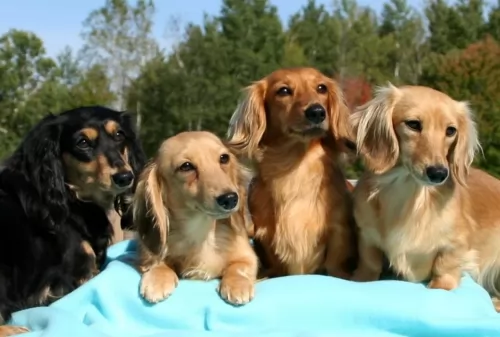 Petzlover
PetzloverBlue Paul Terrier is originated from United Kingdom but Miniature Dachshund is originated from Germany. Blue Paul Terrier may grow 38 cm / 15 inches higher than Miniature Dachshund. Blue Paul Terrier may weigh 20 kg / 45 pounds more than Miniature Dachshund. Blue Paul Terrier may live 5 years less than Miniature Dachshund. Blue Paul Terrier may have more litter size than Miniature Dachshund. Both Blue Paul Terrier and Miniature Dachshund requires Low Maintenance.
Known also as the Scottish Bull Terrier, the Blue Poll or the Blue Poll Bulldog, the Blue Paul Terrier’s origins, as with many unusual dog breeds, are still not known precisely. However they do appear to have been bred with Staffies at some point and appear to have slowly transformed into the Staffie or Pit Bull as we know them today.
There doesn’t seem to be much documentation on the dog’s origins, making many stories of its origins to be looked upon as folklore. It seems as if the dog originated out of Scotland. The name ‘Paul’ is included in the name simply because it is believed that John Paul Jones, who was a sailor, brought the dog to the USA in 1777.
Because this dog has superb fighting skills, it was introduced as part of Staffordshire Bull Terrier breeding in the early 19th century. It is believed that the first dogs came with English immigrants to the United Stated in the middle of the 19th century. At some time, the dog became extinct, but dates of this time can’t be established.
 The Dachshund breed is ancient and was developed in Germany sometime around the 16th century.
The Dachshund breed is ancient and was developed in Germany sometime around the 16th century.
It was in 1870 that Dachshunds first came to the United States to be used for hunting. During the 19th century, German hunters wanted smaller dachshunds.
The Dachshund was crossed with toy terriers. The coat comes in three coats – smooth-, long-haired and wire-haired. There is just one size of Miniature Dachshund in the UK and the United States.
The Blue Paul Terrier was a smooth coated, medium sized dog. His coat was mostly dark blue but this sometimes varied to red or brindle. He was a muscled and well built dog, much like our pit bull terriers. He weighed about 20 to 25kg kg, measuring up to 56cm at the withers. He had a broad chest, large head with small cropped ears and a tail that was set low. He is a dog that always stood strongly on his legs. It seems as if he had an aggressive nature as they were used by local dog fighters.
There is not much information on the temperament of the Blue Paul Terrier, but we can assume, that because he was a Terrier, he would have been full of character and self confidence. Most Terriers don’t actively look for a fight, but will certainly get into a fight if provoked. Aggressive by nature and a fighter, the Blue Paul Terrier possibly had some Staffordshire Bull Terrier in him, so his temperament would be that of a fighter.
He may have been able to live peacefully with children and other dogs and cats in the home, but he would no doubt have had to be raised from a puppy in such a household. Stubborn and headstrong, he would require a firm owner who could take charge of him and training would have been imperative for such a dog.
 Coming in a range of colors such as red, black, black and tan, cream, chocolate etc, the coat of the Miniature Dachshund can be long or short. Both male and females stand at between 13 – 18cm and weigh between 3 and 5kg.
Coming in a range of colors such as red, black, black and tan, cream, chocolate etc, the coat of the Miniature Dachshund can be long or short. Both male and females stand at between 13 – 18cm and weigh between 3 and 5kg.
These dogs are characterized by the long back and very short legs with floppy ears and a long tail. The face is always bright and alert.
The Miniature Dachshund is a small dog and can happily adapt to life in the city as well as in the countryside. This is because with their exercise needs, they don’t require a huge garden but can in fact, exercise indoors.
They’ve always been bred to hunt and are independent and feisty. They’re also intelligent and will do well with training and socialization.
They are also devoted to their families and are known to bark when strangers come near their family. They’ve got a lot of energy and just love being involved with games or going on a walk. Consider him when going on a walk though as his little legs have to take many more steps as compared to your one step.
They can be stubborn, but are friendly, lovable little pets, they aren’t suited for homes with toddlers unless the children have been taught to be exceedingly gentle and kind with animals, especially small, fragile ones like this. They can so easily get hurt.
Nobody is quite certain what the Blue Paul Terrier was like. He definitely seemed to be a mix of Pit Bull and Staffie – the same compact, muscular build with a look that speaks of confidence and boldness.
Perhaps if the Blue Paul Terrier wasn’t used for fighting, he might well have made a good pet with training and socialization. Nobody really knows. Maybe he was so aggressive that when dog fighting didn’t work out, and it was discovered that he wasn't really pet-material, nobody bothered when the breed went into extinction. That's the thing with Blue Paul Terriers, nobody is really certain about what they were really like.
 The Miniature Dachshund has lots of qualities which make him such a splendid pet. He is intelligent, brave, bold and loyal with his human family.
The Miniature Dachshund has lots of qualities which make him such a splendid pet. He is intelligent, brave, bold and loyal with his human family.
He is fun-loving and energetic and thrives on lots of games and walks. He is versatile in nature and also loves to take things easy indoors with his family.
These little dogs form strong bonds with their family and don’t like to be left on their own. When you have one of these as a pet you’re allowing a whole lot of joy into your home.
The Blue Paul Terrier Health was generally a healthy dog, but he would no doubt have had the same common dog ailments that most dog breeds have to contend with. All those years ago, when the Blue Paul Terrier was ill, his owner no doubt would have taken him to see the veterinarian for a full screening.
Just like with other dog breeds, he would have been watched for hip dysplasia , ticks and fleas, cataracts and skin infections. It is possible that in those days, owners of the Blue Paul Terrier weren’t aware of how plaque could cause dental problems or gum disease.
 Be very careful with the Miniature Dachshund because of their long backs. You don't want to be allowing him to be jumping off chairs etc as their backs are prone to injury. To solve the problem you can buy special stairs and ramps for small dogs.
Be very careful with the Miniature Dachshund because of their long backs. You don't want to be allowing him to be jumping off chairs etc as their backs are prone to injury. To solve the problem you can buy special stairs and ramps for small dogs.
They can live to be between 12 and 14 years of age when looked after well.
A disease that is fairly common in the Miniature Dachshund is Intervertebral Disc Disease, a condition where the cushioning discs between the vertebrae of the spinal column bulge or burst into the spinal cord space, pressing on the nerves and causing nerve damage and worse, paralysis.
Because these dogs were used in fighting, it is a breed that no doubt would have required plenty of exercise and mental stimulation to keep him fighting fit. No doubt he would have received a high quality food to build up his strength and stamina. Because he was no doubt a high energy dog, his owners would have had to give him nutritious food and ensured fresh, clean water for him.
The Blue Paul Terrier had a short, smooth coat, so they were no doubt low maintenance dogs who received a brush down every now and then to remove his loose hair.
 Dachshunds can put on weight quickly and you want to avoid this at all costs as extra weight can put strain on the back.
Dachshunds can put on weight quickly and you want to avoid this at all costs as extra weight can put strain on the back.
If you feed your Mini Dachshund commercially manufactured dog food, choose the best quality ones, high in vitamins and minerals and avoid some of the cheaper ones that use unwholesome fillers, colorants, sugar and lots of salt, all of which can be toxic for your pet.
Of course home-made food is always best, but not any foods either. It is best with any dog to keep their foods simple and consistent so as to avoid stomach problems. Chopped up boiled chicken, brown rice or pasta and some cooked vegetables such as potatoes carrots and spinach will do wonders for him. Make sure that there is a constant supply of fresh, cool water for him.
A good brush of the coat twice a week will do fine for your Miniature Dachshund. Remember to check him over for fleas and ticks when you brush him and to feel for any unusual lumps. Keep the nails trimmed.
Check both eyes and ears for infection. There are ways to keep the inside of long eared dog breeds clean and dry, but if you’re unsure there are always professional groomers who will do the job for you, and clean their teeth at the same time. You can brush your dogs teeth 2 or 3 times a week to avoid plaque build up, gum infection and tooth loss.